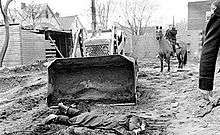Bruce W. Klunder
Reverend Bruce W. Klunder (July 12, 1937 – April 7, 1964[1]) was a Presbyterian minister and civil right activist, born in Colorado. He died when he was run over by a bulldozer while protesting the construction of a segregated school in Cleveland, Ohio.[2] Klunder graduated from Yale Divinity School and then went to Cleveland in 1961 as assistant executive secretary of the Student Christian Union at Western Reserve University. He quickly became involved in the city's civil rights fight.[3] He had a passionate interest in civil rights, headed the local chapter of the Congress of Racial Equality (CORE), and led a restaurant sit-in in Sewanee, Tennessee in 1962. He was married, with two young children.[2]
Reverend Bruce W. Klunder | |
|---|---|
 Klunder in an undated photo | |
| Born | July 12, 1937 Greeley, Colorado, U.S.[1] |
| Died | April 7, 1964 (aged 26) |
| Cause of death | Crushed to death |
| Resting place | Church of the Covenant, Cleveland, Ohio[1] |
| Alma mater | Yale Divinity School Oregon State University |
| Occupation | Minister, activist |
| Years active | 1955–64 |
| Organization | Congress of Racial Equality |
| Movement | Civil Rights Movement |
| Spouse(s) | Joanne Lehman[1] |
| Children | 2 |
Death
Klunder frequently did picket duty, demonstrating for fair housing and against racially segregated public facilities and racial discrimination in hiring. When the Cleveland City School District decided to build new schools that would have reinforced the pattern of segregated neighborhood enrollment, Klunder took the lead in attempting to stop construction.[1]
One afternoon about 100 demonstrators threw themselves at the wheels and treads of bulldozers, power shovels, trucks and mobile concrete mixers to prevent the school from being built. A power shovel operator watched as six people—including a woman five months pregnant—leaped into a ditch and stretched out prone just beneath the shovel's jaws. Police officers tried to disperse the demonstrators, but many came out of the muck fighting. Twenty-one were arrested that day, and two were injured.[3]
The next day Klunder and about 1,000 other demonstrators returned to the school. Already awaiting them were dozens of Cleveland police officers. Moments later, Klunder, two women, and another man dashed across the school lot toward a bulldozer. Three of them flung themselves into the path of the steel treads. Klunder lay down behind the machine. The driver, John White, 33, stopped when he saw the three in front. He looked around but did not see Klunder, and he backed up. When he finally stopped the vehicle, Klunder was dead.[3]

Aftermath
Klunder's death ignited angry confrontations that devolved into "rock-throwing, car-smashing disorders".[4] Cleveland police eventually used tear gas to disperse the crowds, which numbered more than 3,500 protesters.[4] The Plain Dealer reported that "police ... were forced to use tear gas bombs to scatter crowds that would not clear out of the neighborhoods.... Thirteen persons, including eight policemen, were injured in the fighting. Twenty-six persons, including women, were arrested and jailed."[5][6]
The next day, demonstrators formed a silent memorial in front of the Board of Education Building in downtown Cleveland. Funeral services for Klunder were held at the Church of the Covenant. Eugene Carson Blake, head of the United Presbyterian Church, delivered the eulogy and 1,500 people attended.[1][7] Klunder's death polarized the Cleveland community. Some saw his death as an inevitable result of the breakdown of law and order. Others viewed his activism as an act of love.[2]
Klunder is one of the 41 individuals listed as civil rights martyrs at the national Civil Rights Memorial in Montgomery, Alabama.[8]
In 2013, the school whose construction sparked the protests was torn down and long-time Cleveland residents were interviewed about its history. Rev. E Theophilus Caviness of the Greater Abyssinia Baptist Church was at the scene in 1964; he told the Plain Dealer: "Every time I pass that school, it's sacred ground. It's a sacred location to all of us who were here and saw what the struggle was all about."[6][9]
See also
References
- "Klunder, Bruce W." The Encyclopedia of Cleveland History. July 17, 1997. Retrieved April 24, 2016.
- Heuser, Fred. "Stories from Our Past: Presbyterians and the Struggle for Civil Rights" (PDF). Presbyterian Church USA. Retrieved April 24, 2016.
- "We Are Dedicated". TIME. April 17, 1964. Retrieved April 24, 2016.
- "Rights Demonstration Ends in Death of Young Clergyman". The Oneonta Star. Oneonta, NY. AP. April 8, 1964. Retrieved September 2, 2016 – via Newspapers.com.

- Barmann, George J. (April 8, 1964). "City's Worst Rights Violence Erupts After Minister's Death" (PDF). The Plain Dealer. Retrieved April 24, 2016.
- O'Donnell, Patrick (August 31, 2013). "Elementary school whose construction in 1964 led to demonstrations and the death of a protestor will be torn down". The Plain Dealer. Retrieved April 24, 2016.
- "Stephen E. Howe Elementary – The Fight for Equal Schools". Cleveland Historical. Retrieved April 24, 2016.
- "Civil Rights Martyrs". Southern Poverty Law Center. Retrieved April 24, 2016.
- Nutile, Alaina (September 3, 2013). "The Cleveland School Where a Minister Was Once Run Over by a Bull Dozer Will Be Torn Down". Cleveland Scene. Retrieved April 24, 2016.
External links
- Klunder, Joanne (June 1964). "My Husband Died for Democracy". Ebony.
- "Letters to the Editor concerning 'My Husband Died for Democracy'". Ebony. August 1964.
- "Rev. Bruce Klunder". Southern Poverty Law Center.
- "Widow Protests". Jet. June 25, 1964. – photo of Joanne Klunder and daughter picketing the National Governors Conference
- "Convener: Establishing a Groundbreaking Interracial Forum". The Cleveland Foundation. – information about the Businessmen's Interracial Committee on Community Affairs, an organization formed in the wake of Klunder's death and supported by the Greater Cleveland Associated Foundation, which merged into the Cleveland Foundation